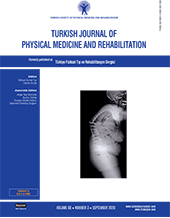The rate of intraspinal problems and clinical evaluation of scoliosis: A cross-sectional, descriptive study
Patients and methods: This cross-sectional, descriptive study included a total of 36 patients (11 males, 25 females; mean age 13.4±4.6 years; range, 6 to 24 years) with idiopathic scoliosis between January 2015 and January 2019. Data including age, sex, complaint of pain, generalized joint hypermobility (based on Beighton score), neurological deficit, ankle deformity, and definition of scoliosis were recorded. Chronological, angular, and topographic classification were carried out. The Risser grade and MRI findings were noted.
Results: Of all patients, 30 (83.3%) were idiopathic, five (13.9%) were neuromuscular, and one (2.8%) was congenital scoliosis based on MRI findings. Of 13 (36.1%) spine MRI scans, six (46.2%) were intraspinal anomalies, four were syringomyelia (30.8%), one was Chiari type 1 malformation (7.7%), and one was hemivertebrae with diastematomyelia (7.7%). The highest rates of classes according to chronological, angular, and topographical classifications of idiopathic scoliosis were adolescent (17/30, 56.7%), low angular (24/30, 80.0%), and lumbar scoliosis (15/30, 50.0%), respectively. Ten patients (33.3%) complained of pain, while 23 patients (76.7%) had no neurological deficit and seven (23.3%) had hypoesthesia. Seventeen patients (56.7%) had generalized joint hypermobility.
Conclusion: Idiopathic scoliosis with non-severe spinal deformity may present with intraspinal neural axis abnormalities, even when it is neurologically intact. Based on our study results, it seems to be useful to consider whole spine MRI for the evaluation of thoracic and lumbar scoliosis.
Keywords : Chiari, hypermobility, scoliosis, spine, syringomyelia

















